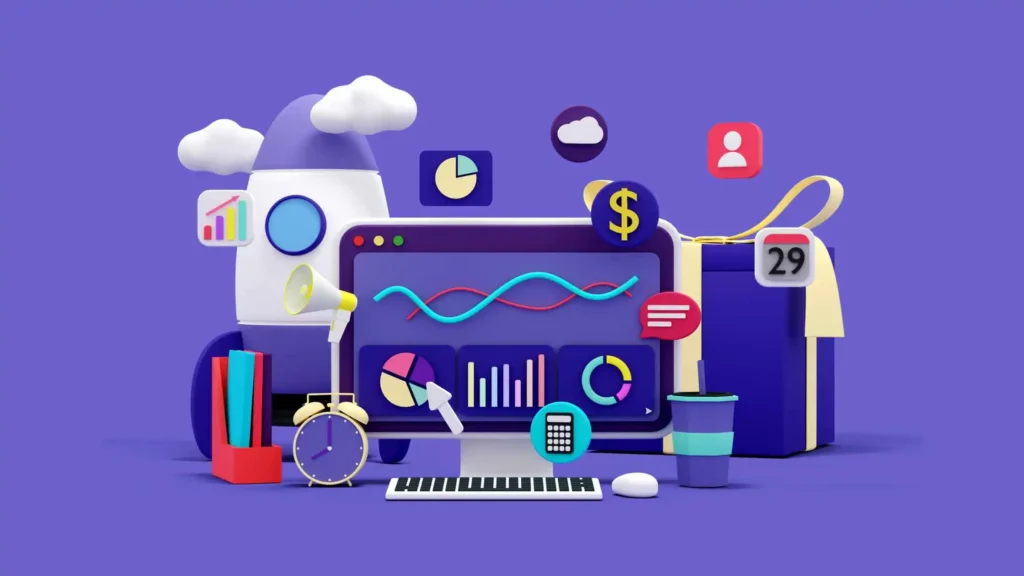Do you wants to find out the top features and functions of Microsoft Power BI? If yes, Congrats! The time has come to make it happen!
Microsoft Power BI is a powerful business intelligence tool that enables users to extract valuable insights from their data and present them in a visually appealing and interactive manner.
With a wide range of features and functions, Power BI has become a popular choice among organizations seeking to gain a competitive edge.
So are you ready to explore the top features and functions of Microsoft Power BI and how they can empower businesses to harness the full potential of their data?
Let’s go ahead!

Here’s the Features and Functions of Microsoft Power BI
Microsoft Power BI offers an extensive array of features and functions that empower users to unlock the true potential of their data.
Let’s delve into the top features and functions that make Power BI a go-to choice for businesses seeking to derive valuable insights from their data.
1. The Power of Data Visualization
Data visualization is a crucial aspect of data analysis as it enables users to comprehend complex information quickly.
Power BI provides a rich set of visualizations, including charts, graphs, maps, and gauges, to present data in a visually appealing and interactive manner.
The drag-and-drop interface allows users to effortlessly create compelling visualizations without the need for complex coding or programming skills.
Power BI’s visualizations can be customized to match the branding and design aesthetics of an organization.
Users can apply various formatting options, color schemes, and themes to create visually stunning dashboards and reports.
Moreover, interactive features like drill-through, cross-filtering, and tooltips enable users to explore data at different levels of granularity, gaining deeper insights with just a few clicks.
2. Interactive Dashboards for Real-Time Insights
With Power BI’s interactive dashboards, users can monitor key performance indicators (KPIs) and track real-time metrics to make informed decisions on the fly.
Dashboards provide a consolidated view of critical business metrics by combining data from multiple sources into visually appealing tiles.
These tiles can be pinned to a dashboard and rearranged to create a personalized and intuitive view of the data.
Power BI dashboards are highly interactive, allowing users to explore data from different angles and perspectives.
Users can apply filters, slicers, and drill-through options to gain deeper insights and identify trends or outliers.
With real-time data refresh capabilities, dashboards can provide up-to-date information, ensuring that users always have access to the most current insights.
3. Advanced Data Modeling and Transformations
Power BI offers powerful data modeling capabilities that enable users to shape and transform raw data into meaningful insights.
With Power Query, users can connect to various data sources, perform data transformations, and create a robust data model.
Power Query’s intuitive interface allows users to clean, transform, and reshape data with ease, even if they have limited programming knowledge.
The data model created in Power BI provides a foundation for analysis and visualization.
Users can define relationships between tables, create calculated columns and measures using the DAX (Data Analysis Expressions) language, and leverage hierarchies to facilitate drill-down analysis.
Power BI’s data modeling capabilities ensure that users have a solid foundation for deriving valuable insights from their data.
4. Natural Language Query for Intuitive Analysis
One of the standout features of Power BI is its natural language query functionality.
With this feature, users can ask questions about their data using plain English and receive instant visualizations and insights.
Power BI utilizes advanced natural language processing algorithms to understand user queries and generate relevant visualizations based on the data model.
Natural language query makes data analysis more accessible to users who may not be familiar with the underlying data structure or technical jargon.
It enables business users to gain insights from their data without the need to write complex queries or navigate through multiple menus.
By simply typing or speaking their questions, users can get immediate answers and explore their data in a conversational and intuitive manner.
5. Seamless Data Integration from Multiple Sources
Power BI offers seamless integration with a wide range of data sources, allowing users to connect to various databases, cloud services, files, and streaming data.
The Power BI service provides connectors for popular data sources like Microsoft Excel, SQL Server, SharePoint, Azure, Salesforce, and many more.
These connectors enable users to establish a live connection or import data into Power BI for analysis and visualization.
Users can leverage Power Query to perform data transformations and combine data from multiple sources into a single cohesive dataset.
The ability to connect to diverse data sources ensures that users have access to a comprehensive view of their data, enabling them to uncover hidden insights and correlations that would otherwise remain undiscovered.
6. Collaboration and Sharing Capabilities
Power BI promotes collaboration and knowledge sharing within organizations by providing robust collaboration and sharing capabilities.
Users can create workspaces and invite team members to collaborate on reports and dashboards.
The sharing options allow users to control access to the content, specifying whether recipients have view-only or edit permissions.
Power BI also offers the ability to create content packs, which are pre-packaged collections of dashboards, reports, and datasets that can be easily shared with others.
Content packs streamline the process of sharing and distributing insights, ensuring that relevant stakeholders have access to the latest information.
Furthermore, Power BI integrates seamlessly with other Microsoft collaboration tools like SharePoint and Teams, enabling users to embed reports and dashboards directly into these platforms.
This integration facilitates the dissemination of insights across the organization and promotes a data-driven culture.
7. Mobile Accessibility for On-the-Go Insights
In today’s mobile-centric world, having access to data and insights on the go is essential for making informed decisions.
Power BI provides native mobile apps for iOS and Android devices, allowing users to access their reports and dashboards anytime, anywhere.
The mobile apps offer a responsive and touch-friendly interface, ensuring a seamless user experience across different screen sizes.
The mobile apps provide rich interactive capabilities, enabling users to drill down into data, apply filters, and explore insights directly from their mobile devices.
Users can receive notifications and alerts based on predefined conditions, ensuring that they stay informed about critical changes or anomalies in the data.
8. Advanced Analytics with AI and Machine Learning
Power BI incorporates advanced analytics capabilities, empowering users to leverage the power of artificial intelligence (AI) and machine learning (ML) for data analysis.
Power BI integrates with Azure Machine Learning, allowing users to build and deploy ML models directly within Power BI.
These ML models can be used to generate predictions, classify data, detect anomalies, or perform sentiment analysis.
Additionally, Power BI offers built-in AI visuals such as key influencers, decomposition trees, and clustering, which enable users to uncover patterns and relationships in their data.
These AI-powered visuals provide a deeper level of analysis and help users gain insights that may not be immediately apparent through traditional visualization techniques.
9. Customizable and Extensible through Power BI Apps
Power BI provides a platform for creating custom applications, known as Power BI apps, that extend the capabilities of the tool.
Power BI apps allow users to package dashboards, reports, and datasets into a single application that can be easily installed and shared with others.
These apps can include custom visuals, custom branding, and tailored experiences for specific user groups.
By creating Power BI apps, organizations can deliver tailored analytics solutions to different departments, teams, or external stakeholders.
Power BI apps can be published to the Power BI AppSource marketplace, making them accessible to a wider audience and fostering a community of developers and users.

10. Security and Compliance Features
As data security and compliance become increasingly important, Power BI offers robust features to ensure the confidentiality, integrity, and availability of data.
Power BI incorporates role-based security, allowing administrators to define access rights and permissions at various levels, such as workspace, report, or dataset.
Power BI also supports row-level security, which enables organizations to restrict data access based on user roles or attributes.
This feature ensures that users only see the data they are authorized to view, maintaining data privacy and confidentiality.
Furthermore, Power BI complies with industry-leading security standards and certifications, such as ISO 27001, HIPAA, and GDPR.
The Power BI service is built on Azure, Microsoft’s secure cloud platform, which provides industry-leading security measures to protect data at rest and in transit.
11. Data Alerts and Notifications
To stay informed about changes in data and key performance indicators, Power BI offers data alerts and notifications.
Users can define thresholds or conditions based on their data and set up alerts to trigger when these conditions are met.
Alerts can be configured to send notifications via email or mobile push notifications, ensuring that users are promptly notified of critical changes.
Data alerts enable users to proactively monitor their data and take immediate action when anomalies or significant trends are detected.
This feature empowers organizations to respond swiftly to changing business conditions and make data-driven decisions in a timely manner.
12. Row-Level Security for Enhanced Data Protection
Data security is a critical concern for organizations, and Power BI addresses this by providing row-level security (RLS) capabilities.
RLS allows administrators to define fine-grained access controls at the row level, restricting data visibility based on user roles or attributes.
With RLS, organizations can ensure that sensitive or confidential data is accessible only to authorized users, while other users see a filtered view of the data.
This level of granular security enables organizations to comply with data protection regulations and maintain data privacy.
13. Real-Time Streaming and IoT Integration
Power BI enables real-time streaming and integration with Internet of Things (IoT) devices, allowing organizations to gain insights from streaming data sources.
Using Power BI’s streaming datasets, users can visualize and analyze data as it arrives, enabling real-time monitoring and decision-making.
Power BI also integrates with Azure IoT Hub, a cloud service that connects, monitors, and manages IoT devices.
This integration allows organizations to ingest and analyze data from IoT devices in real-time, uncovering valuable insights and enabling proactive actions based on IoT data.
14. Report Publishing and Embedding
Power BI enables users to publish reports and share them with others, both within and outside the organization.
Reports can be published to the Power BI service or exported as files, such as PDF or PowerPoint, for offline viewing and distribution.
Moreover, Power BI provides embedding capabilities, allowing users to embed reports and dashboards into other applications or websites.
This feature enables seamless integration of Power BI insights into existing workflows or customer-facing applications, enhancing the accessibility and reach of data-driven insights.
15. Data-Driven Subscriptions
Power BI offers data-driven subscriptions, which allow users to schedule and automate the delivery of reports and dashboards to stakeholders.
Users can define the recipients, delivery frequency, and format of the subscriptions, ensuring that the right information reaches the right people at the right time.
Data-driven subscriptions enable organizations to establish a regular cadence of reporting and ensure that decision-makers have access to the latest insights without manual intervention.
This feature streamlines the process of information dissemination and promotes a data-driven decision-making culture.
16. Hierarchical and Drill-Down Analysis
Power BI supports hierarchical and drill-down analysis, allowing users to navigate through data at different levels of detail.
Users can create hierarchies within their data model, such as year > quarter > month, or region > country > city, and perform drill-down analysis to explore data at each level.
Drill-down analysis empowers users to uncover trends, patterns, and anomalies by progressively exploring data at finer levels of granularity.
This feature enables users to dive deep into their data and gain a comprehensive understanding of the underlying factors driving the observed trends or outcomes.
17. Performance Optimization and Query Acceleration
To ensure optimal performance and responsiveness, Power BI offers various techniques for performance optimization and query acceleration.
Users can apply query folding, a technique that pushes data transformations and filtering operations to the underlying data source, reducing the amount of data transferred and improving query performance.
Power BI also supports direct query mode, which allows users to connect to large-scale data sources and perform analysis directly against the data source without importing the data into Power BI.
This mode ensures real-time access to data while leveraging the query optimization capabilities of the data source.
Additionally, Power BI provides performance analyzer tools that help identify and optimize slow-performing queries or visualizations.
These tools provide insights into query execution times, data load performance, and visualization rendering, enabling users to optimize their reports and dashboards for enhanced performance.
18. Data Profiling and Quality Assessment
Power BI includes data profiling capabilities that enable users to assess the quality and integrity of their data.
Data profiling provides summary statistics, data distribution analysis, and data validation checks to identify potential data quality issues, such as missing values, outliers, or inconsistent formats.
By performing data profiling, users can gain insights into the overall data quality and identify areas for data cleansing and improvement.
Power BI’s data profiling features empower organizations to ensure that their data is reliable and accurate, enhancing the trustworthiness of the insights derived from the data.
19. Export and Printing Options
Power BI allows users to export their reports and dashboards in various formats for offline viewing, sharing, or printing. Users can export reports as PDF, PowerPoint, Excel, or CSV files, providing flexibility in how the insights are consumed and shared.
Furthermore, Power BI supports printing of reports and dashboards, enabling users to generate physical copies of the insights for meetings, presentations, or documentation purposes.
The printing options ensure that users can effectively communicate and distribute the insights derived from Power BI to stakeholders in different formats.
20. Natural Language Generation (NLG) Integration
Power BI integrates with Natural Language Generation (NLG) platforms, allowing users to generate human-like narratives and summaries based on their data.
NLG platforms use advanced algorithms to analyze data and automatically generate coherent and understandable narratives that highlight key insights, trends, and anomalies.
The integration of NLG with Power BI adds another layer of storytelling and interpretation to the data visualizations, making the insights more accessible and understandable to a wider audience.
NLG-generated narratives can be embedded within reports or shared alongside visualizations, enhancing the overall communication and comprehension of the insights.
21. Custom Visualizations and Marketplace
Power BI provides a marketplace for custom visualizations, where users can find a wide range of visualizations created by the community or third-party developers.
These custom visualizations expand the visualization options available in Power BI, enabling users to create unique and tailored visual representations of their data.
Users can also create their own custom visualizations using Power BI’s developer tools and publish them to the marketplace for others to use.
This extensibility allows organizations to build custom visualizations that cater to their specific needs or industry requirements, enhancing the effectiveness and impact of data visualizations.
22. Advanced Forecasting and What-If Analysis
Power BI offers advanced forecasting and what-if analysis capabilities, empowering users to predict future outcomes and explore hypothetical scenarios based on their data.
The forecasting feature utilizes statistical algorithms to analyze historical data and generate predictions for future periods, providing insights into potential trends or patterns.
The what-if analysis feature allows users to simulate the impact of changes in variables or assumptions on key metrics or outcomes.
Users can define different scenarios, adjust parameters, and instantly see the projected impact on the data and visualizations.
These features enable users to make informed decisions by understanding the potential consequences of different actions or scenarios.
23. Integration with Azure Services
Power BI seamlessly integrates with various Azure services, expanding its capabilities and enabling users to leverage the power of the Azure ecosystem.
Integration with Azure services like Azure Machine Learning, Azure Data Lake Storage, and Azure SQL Database allows users to incorporate advanced analytics, big data processing, and scalable storage solutions into their Power BI workflows.
By integrating with Azure services, Power BI extends its functionality and provides access to a broader set of tools and technologies for data analysis, processing, and storage.
This integration enables organizations to build end-to-end data solutions that span from data ingestion and transformation to advanced analytics and reporting.
24. Data Connectivity and On-Premises Gateway
Power BI offers extensive data connectivity options, allowing users to connect to on-premises data sources and cloud-based services.
The On-Premises Data Gateway enables secure and encrypted communication between Power BI and on-premises data sources, ensuring data privacy and integrity.
The On-Premises Data Gateway establishes a bridge between Power BI and on-premises data sources, enabling users to refresh data, schedule data refreshes, and access real-time data from on-premises databases or applications.
This connectivity option ensures that users can leverage Power BI’s capabilities to analyze and visualize data from a wide range of sources, regardless of their location or accessibility.
25. Advanced Data Transformation and Merging
Power BI provides advanced data transformation capabilities, allowing users to clean, reshape, and merge data from multiple sources to create a unified and coherent dataset.
Users can perform various data transformation operations, such as filtering, sorting, grouping, aggregating, and merging tables, to prepare the data for analysis and visualization.
The data transformation features in Power BI enable users to handle complex data scenarios and create meaningful relationships between different datasets.
This capability ensures that users can work with diverse and disparate data sources, harmonize the data structure, and derive valuable insights from the combined data.
Can I access Power BI from my mobile device?
Yes, Power BI provides native mobile apps for both iOS and Android devices.
These mobile apps allow you to access your reports and dashboards on the go, providing real-time insights at your fingertips.
Can I collaborate and share my Power BI reports with others?
Absolutely! Power BI offers robust collaboration features, allowing you to share your reports and dashboards with colleagues, stakeholders, or clients.
You can control access rights, collaborate in real-time, and embed reports in other platforms like SharePoint and Teams.
Does Power BI support real-time data streaming and integration with IoT devices?
Yes, Power BI supports real-time data streaming and integration with IoT devices.
You can connect to streaming data sources and analyze the data as it arrives, gaining immediate insights and monitoring live data streams.
Can I customize the visualizations in Power BI?
Yes, Power BI provides a wide range of visualizations out of the box, and you can also find custom visualizations in the Power BI marketplace.
Furthermore, you can create your own custom visualizations using Power BI’s developer tools.
How does Power BI ensure data security and compliance?
Power BI incorporates robust security features, including role-based security, row-level security, and compliance with industry standards such as ISO 27001, HIPAA, and GDPR.
The Power BI service is built on Azure, which provides industry-leading security measures.
Can I perform advanced analytics and machine learning in Power BI?
Certainly! Power BI integrates with Azure Machine Learning, allowing you to build and deploy machine learning models directly within Power BI.
You can generate predictions, perform clustering, or analyze key influencers using advanced analytics capabilities.












Pingback: Here's How to Use Microsoft Power BI for Business Intelligence
Pingback: The Difference between Power BI Desktop and Power BI Service